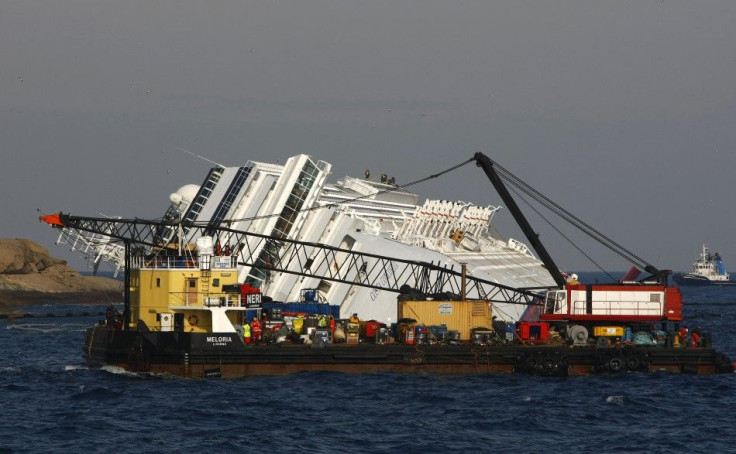Cruise Ship Sinking: Concordia to Remain Submerged Through the Summer

It could take a salvage crew up to 10 months to remove the wreck of the Costa Concordia, the cruise ship that sank off of Italy's Giglio Island earlier this month.
Dutch company Smit Salvage is prepared to begin removing fuel from the sunken vessel -- the first step in the recovery process -- but rough seas and bad weather have delayed the go-ahead order from Italian authorities.
The oil extraction process is only expected to take up to four weeks if it starts immediately and continues uninterrupted, and the actual removal of the ship could require an additional seven months or more.
As of Friday, Smit had a team of 35 people on stand-by to start with the vessel survey, ahead of the removal of fuel, as well as all the salvage equipment needed.
Equipment to remove the fuel include a crane/work barge with pumps, hoses, air-diving equipment, [while a] steam/heating plant onboard have been mobilized... and are ready to start the work, Smit stated.
The time-frame has residents of Giglio Island worried. The longer the ship stays in the water, the greater the chance of an environmental disaster occurring in a body of water that has has received awards for being the cleanest and clearest in Italy. Additionally, an oil spill could damage the area's rich fishing grounds, as well as the protected Pelagos marine mammal preserve that covers northern Italy, Monaco and part of the French Riviera.
The ship is already leaking light fuel, the Associated Press reported on Saturday, and a perimeter of oil-absorbing material has been built around the Concordia.
Aside from fuel, chemicals, determent, solvent and other materials could contaminate the waters. Likewise, deck furniture, garbage and many other items on board could fall out of the ship; a number of tables and chairs were visible floating around the wreck days after the accident.
They say there is not going to be any environmental damage, but we are not stupid, Riccardo Vicchianti, the son of a Giglio resident, told The Associated Press.
The damage to the environment is strong. If I think of just one cabin, it's like throwing a whole bar into the sea. That alone, I think, can pollute with just what it contains. Imagine a floating town!
The Costa company has already taken a financial hit in the wake of the Concordia disaster, but the 10-month clean-up could affect Giglio too. The island is a popular destination for Italian tourists in the summer. The population swells from 1,000 to 15,000 people during the summer months, but an environmental concerns could keep visitors, divers and snorkelers away, The Telegraph noted on Monday.
Moreover, the rescue and salvage boats could clog the harbor and keep out celebrity yachters.
It will be a long operation but we need to make sure the holiday season won't be ruined, Mayor of Giglio Sergio Ortelli told SkyTG24.
Hot Tapping
Smit is going to use a process called hot-tapping to get the 500,000 gallons of fuel safely out of the Concordia.
The first step in hot-tapping is cutting a hole through the ship's hull and into the oil tanks, which is done with a special device to minimize the amount of fuel that leaks out in the process. This will have to be done to the Concordia by special divers.
Next, a valve is attached to the ship, followed by a pipe and a heater that shoot hot water into the boat, thereby replacing the oil that is sent up through the pipe to a Smit salvage ship, and from there into an oil tanker.
The advantage to hot-tapping is that it doesn't change the equilibrium of the ship, and it can be done without any additional operations, such as cutting vents. If the Concordia were to get any further off-balance there is a strong chance that it could topple off the reef and fall completely underwater -- dangerous both because the fall could rupture the tanks and because it would make salvage efforts considerably harder.
Once the oil is completely removed, the salvage team will be faced with their next titanic task -- the removal of the ship itself. The Mirror's cruise ship reporter John Honeywell, also known as Captain Grey Beard, reported that Costa isn't sure what the future holds for the Concordia.
We cannot speculate about the future of the vessel until these operations are complete, a Costa spokesperson stated.
A damage assessment review of the vessel is currently being undertaken to determine how long it will be out of service. [It] is expected to be out of service for the remainder of our fiscal year, if not longer.
If the company were to try to repair the ship for future voyages, which, despite the 160 foot gash in the hull, is still a possibility, Smit will have to raise the ship with one of the floating cranes, and then tow the boat away. The other option, if Costa determines that the ship cannot be repaired, would entail Smit cutting the boat into pieces and tow it that way.
Search Continues
At least 17 people were killed when the Concordia sank on Jan. 13. Another 16 passengers and crew members are still listed as missing, and the search for bodies continues.
Rescuers have given up hope of finding anyone still alive on the ship, but are determined to recover all the bodies before giving a final death toll.
© Copyright IBTimes 2024. All rights reserved.











